Total Number of seeds: 25
The Butter Beans Seeds are a bush-type legume variety known for their fast growth, high yield, and soft buttery texture. These plants grow compact and sturdy, producing clusters of green pods filled with tender, creamy beans. The beans are rich in protein, fiber, and essential minerals, making them a healthy and versatile ingredient for Indian kitchens.
These Butter Beans Seeds perform exceptionally well in the Indian climate, especially when sown between June and October. They are ideal for pots, terrace gardens, and open fields. The plants require minimal maintenance and offer consistent production for several months. With a growth period of around 120–130 days, this bush variety ensures both steady harvests and excellent taste. Whether cooked in curries, stir-fries, or soups, butter beans add a smooth and flavorful touch to any dish.
Type of Seed: Bush Type Butter Beans
Germination Time: 5–8 days
Hours of Sunlight Needed: 6–8 hours daily
Where to Grow: Pots, terrace gardens, or open fields
Growing Season: June to October (Kharif season)
Seed Sowing Depth: 4–5 cm deep
Ideal Climate: Warm and moderately humid
Plant Height: 60–90 cm (bushy growth)
Fertilizer Needs: Apply compost or organic manure every 15 days
Life Span: 120–130 days
Ideal Growing Temperature: 22–30°C
Harvesting Time: 50–60 days after sowing
Maintenance Required: Low; requires minimal staking
Watering Frequency: Regular, keeping soil moist but not soggy
Ideal Grow Bag Size: 18x18 inch or larger


The Butter Beans Seeds thrive best in the monsoon and post-monsoon seasons, from June to October. In southern regions, they can also be grown during the cooler months with proper irrigation. Avoid frost and extreme heat to maintain healthy growth and maximum yield.
Select a large grow bag (18x18 inch) with proper drainage. Fill it with a mix of garden soil, compost, and cocopeat. Sow 2–3 seeds per pot at a depth of 4–5 cm and water gently. Place the pot in an area with at least 6 hours of sunlight. Once seedlings grow 5–6 inches tall, keep the healthiest one for better productivity.
Preparation: Loosen the soil and mix it with compost or organic manure.
Sowing: Sow seeds 4–5 cm deep and space plants 2 feet apart.
Watering: Keep soil evenly moist for steady germination.
Germination: Seeds sprout in 5–8 days under warm conditions.
Transplanting: Direct sowing is recommended; no need for transplanting.
Sunlight: Provide 6–8 hours of sunlight daily.
Soil: Use well-drained, fertile soil enriched with compost.
Fertilization: Add organic manure every 15 days for vigorous growth.
Pruning: Remove yellow or dry leaves to maintain plant health.
Support & Spacing: Maintain 2 feet spacing between plants.
Pest Control: Spray neem oil every 10 days to prevent aphids and beetles.
Disease Prevention: Avoid waterlogging to prevent fungal infections.
Mulching: Retains soil moisture and reduces weeds.
Harvesting: Pick pods when they turn bright green and feel tender.
1. Apply Nutrient-Rich Fertilizers
When your plants begin flowering, use nutrient-rich fertilizers like Organic Bone Meal Powder or Vermicompost. This helps in boosting the bloom and enhances overall yield.
2. Use Organic Fertilizers
Feed your plants with organic fertilizers such as Cow Dung Manure or Neem Cake. Organic options promote healthy soil life.
3. Regular Feeding
Apply fertilizers every 20-25 days to ensure plants receive a steady supply of nutrients. Choose from various options like Cocopeat Compost for moisture retention.
The Butter Beans Seeds produce high-yielding, bushy plants suitable for small and large gardens alike. The plants are drought-tolerant, easy to manage, and require no trellis or support. Their beans are buttery, soft, and packed with protein. The crop has a short maturity period and gives abundant harvests under minimal care, making it a great choice for home gardeners.
Butter beans are a rich source of protein, fiber, and antioxidants. They support heart health, aid digestion, and provide long-lasting energy. These beans are delicious when cooked in curries, soups, and stir-fries. Growing your own Butter Beans ensures fresh, organic produce for a healthy lifestyle.
Avoid overwatering, as excess moisture may cause root rot. Maintain proper sunlight and spacing between plants. Apply only organic fertilizers and compost for best results. Harvest regularly to encourage new pod formation and prolonged yield.
Yellow Leaves: Caused by poor drainage; loosen soil and reduce watering.
Pests (Aphids/Beetles): Use neem oil spray weekly.
Fungal Diseases: Avoid wet leaves and ensure proper air circulation.
Slow Growth: Add organic compost or balanced NPK fertilizer.
Local Names of Butter Beans: Sem Phali, Val Beans, Surti Papdi, Double Beans, Valakkaya, Avarakkai, Chikkudu Kaaya, and Valachya Shevga.
Q1: Can Butter Beans be grown in pots?
Yes, bush-type plants grow well in large pots or grow bags with rich soil.
Q2: How long does it take to harvest?
The first harvest can be done 50–60 days after sowing.
Q3: What type of soil is best?
Loamy, well-drained soil enriched with organic compost works best.
Q4: How often should I water the plants?
Keep the soil evenly moist but never waterlogged.
Q5: Are these seeds hybrid or heirloom?
They are open-pollinated bush-type seeds, ideal for organic gardening.
Sign in now to receive a 5% instant discount on your first order when using code WELCOME. Begin your organic journey today!
By logging in, you're agreeing to our Terms of Service and Privacy Policy.
Rohit Sen
Seeds ka quality top notch. Har seed germinate hua. Strong plants aur good yield. 🌱
Manisha Rao
Bahut achhe seeds hain. Fast germination aur ekdam fresh pods. Recommend karti hu sabko.
Gaurav Mishra
Good yield aur thick green pods. Perfect for terrace garden growers. Bahut easy to maintain.
Kavya Dey
Thoda slow germination hua but healthy plants ban gaye. Regular watering zaroori hai. 🌱
Vikram Joshi
Seeds moisture-proof pack me aaye. Storage aur sowing dono easy. Growth uniform raha. 🌿
Priya Sharma
Golden Hills Farm se second order hai. Har baar quality excellent milti hai. Fully satisfied. 🌱
Arjun Varma
Packaging safe thi. Germination 80-85% mila. Beans pods fat aur tender hain. 🌿
Simran Kaur
Germination perfect hua aur plants healthy. Harvest karne ke baad beans ka taste bhi great tha. 😋
Ashok Menon
Seeds small size ke the par healthy. 3rd day se hi sprouting start ho gayi. 🌱
Nisha Reddy
High quality seeds. 100% germination mila. Water regularly diya toh growth super fast hui.